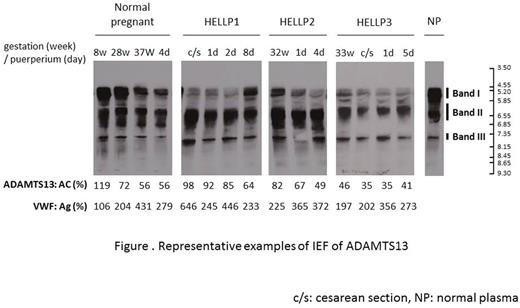Abstract
Introduction
Plasma ADAMTS13 exists at least two forms, bound and unbound to vonWillebrandfactor (VWF), of which the former was assumed to be 3% of the total by the immunoprecipitation method (Feyset al., JTH 2009). We have shown that plasma ADAMTS13 consists of 3 group bands, by means of isoelectric focusing (IEF) analysis (Hori et al, Transfusion 2013). Band I (pI4.9-5.6) was assumed to be free ADAMTS13, unbound to VWF, and Band III (pI7.0-7.5) was a complex with high-molecular-weight VWFmultimers(HMW-VWFM). However, the feature of Band II (pI5.8-6.7) was undetermined.
HELLP (hemolysis, elevated liver enzymes and low platelet counts) syndrome is a life-threatening thromboembolic complication during pregnancy, and its pathogenesis is not determined. The curative therapy of HELLP syndrome is a termination of pregnancy. It was reported that plasma VWF antigen (VWF: Ag) was remarkably increased (215-422% of the normal) with a mild reduction of ADAMTS13 activity (ADAMTS13: AC) (12-43 % of the normal), but without qualitative analysis of ADAMTS13 antigen (Lattuadaet al.,Haematologica2003).
We here analyzed plasma ADAMTS13 antigen in 9 patients with HELLP syndrome using the IEF gel, and revealed a unique picture of severe reduction of Band I (free ADAMTS13), unbound to VWF, that was not seen in plasmas from normal pregnancy.
Patients and Methods
One hundred twenty-nine normal pregnant women and 9 patients with HELLP syndrome were analyzed under approval by the ethics committees of Nara Medical University. All individuals gave written informed consent to the study. Diagnosis of HELLP syndrome was made by all the following laboratory abnormalities: characteristics peripheral blood smear, serum LDH >600 IU/L (or total bilirubin >1.2 mg/dL), AST >70 IU/L, and platelet counts < 100,000/mm3 (Sibai et al., Am JObstetGynecol 1993). Plasma level of ADAMTS13: AC was determined by chromogenic ADAMTS13-act-ELISA, and VWF: Ag was measured by a sandwich ELISA using a rabbit polyclonal anti-human VWF antibody. As reported previously (Hori et al., Transfusion 2013), the IEF was performed using a large-pore agarose-acrylamide composing gel followed by detection with anti-ADAMTS13 monoclonal antibody.
Results
In normal women, plasma levels of VWF: Agweremarkedly increased during pregnancy, and the values of third trimester (median 223%) were almost two times higher than those of first trimester (119%). Contrarily,plasma levels ofADAMTS13: AC were significantly decreased in second (68.4%) and third (66.2%) trimester compared with first trimester (84.3%, p<0.01 and p<0.001, respectively). Of note, a reduction in ADAMTS13: AC was significantly prolonged in postpartum period (50.2%, p<0.001), while increased VWF: Ag was rapidly recovered after delivery. Further, the IEF analysis of normal pregnant women showed that Band I was slightly decreased in accord with progression of pregnancy.
In puerperium, there was no difference in ADAMTS13: AC between normal pregnant women and patients with HELLP syndrome. However, the values of VWF: Ag of patients with HELLP syndrome (352%) were significantly higher than those of normal pregnant women (178%, p<0.001), in agreement with a previous report. Interestingly, however, here we have shown that 7 out of 9 patients with HELLP syndrome showed severe reduction of Band I in puerperium period by the IEF analysis of ADAMTS13 (Figure).
Discussion
In normal pregnant women, the decreased ADAMTS13:AC was assumed to reflect a consumption of the enzyme for cleavage of increased VWF. Interestingly, both Band II and III were almost unchanged during normal pregnancy, but Band I slightly decreased in third trimester, concomitantly with a mild reduction of ADAMTS13:AC. In contrast, Band I was severely reduced during the acute phase of HELLP syndrome in 7 out of 9 patients.
Our previous report indicated that under high-shear-stress Band I inhibited the VWF-dependent platelet aggregation in a dose-response manner from the initial phase, whereas Band III (+II) worked from the later phase. This result indicates that ADAMTS13 lacking Band I neither readily binds to VWF nor efficiently blocks the heightened high-shear-stress induced platelet aggregation generated by newly produced HMW-VWFM. Our data suggest that ADAMTS13 preparation might be used as a therapeutic option for the treatment of HELLP syndrome, before termination of pregnancy.
No relevant conflicts of interest to declare.
Author notes
Asterisk with author names denotes non-ASH members.


This feature is available to Subscribers Only
Sign In or Create an Account Close Modal